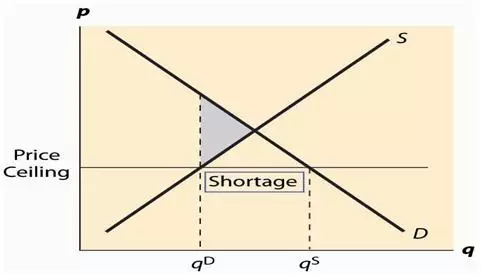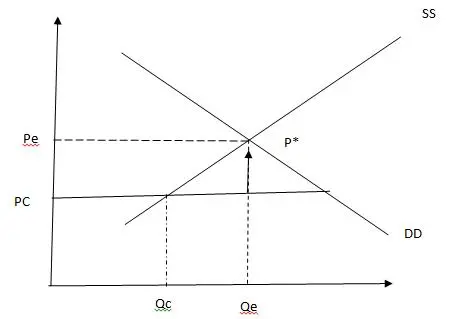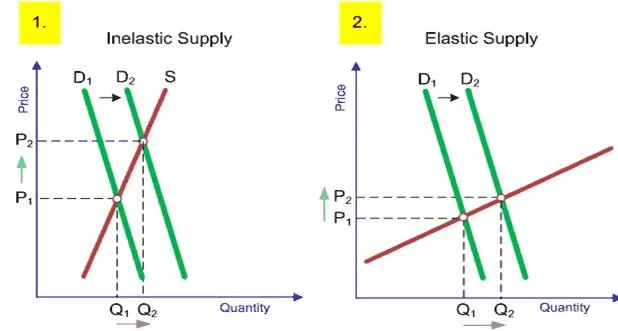Impact of Binding Price Ceiling On Tertiary Education
Question
Task: Draft a report on the impact on the binding price ceiling on Tertiary Education.
Answer
The market of Tertiary Education Under Regulation (Pricing Ceiling)
If there are no specific interventions or price control from the behave of domestic government, the market would get the ability to control the factors and prices in a very balanced way. In the context of the meeting point among the equilibrium supply and the demand curve, the value of the supplied amount of goods would satisfy and tantamount to the value of products demanded. If the government intends to interfere with the processes in the economy, the tool of binding price ceiling comes very handily in creating a change or imbalance in the situation. Only after the long period of applications, the binding price ceiling would show any effect and hence for the instant change the tool sometimes turns out to be an utter failure. The instance of the binding price ceiling occurs when the government determines a specific price on the goods and services below the level of equilibrium. Since the level of price would be much below the level of equilibrium, the firms in the market would be forced to reduce the production of the products which leaves the demand and requirement of the consumers dissatisfied. Hence the market faces the lack of required goods and this shortage would lead to an abnormal increase in the demand. The main motive of the binding price ceiling is to make the market a little volatile by the means if executive policies which make it the breach of law if the goods are sold at a price above the level of a binding price ceiling. The short-term effect of this tool is to reduce the black-market agents in the market and if countered with the long-term result, the demand for the goods remains high in the market. If the black market remains existent in the economy, then the consumer tends to buy unlawful or banned products in the market at a very high and inflated price. The major characteristics of this tool are that it eventually brings up a system of first come first serve service. If the product remains unavailable in the market would try to get access to it somehow by unlawful methods like smuggling, bribing, etc. It is also possible that some marketers or traders in the market would provide their goods or services to the customers who would satisfy the certain set of eligibility or parameters like only providing the products if they are being introduced or referred by the existing customer of the company. In this situation, government interventions like allotting a certain amount of ration to each individual makes certain the even distribution of the products.
If taking the instance of real estate in the economy, the government intervenes by using the rent control policy in the area. In the majority of the cases, the municipality or other local government bodies sets the rate of rent so that a certain level should be set for the land making the land affordable for all the buyers. Although if the rent control remains for a long period, a black market would arise in the field for real estate, since there would be a high demand for porch, residential, rural or industrial area.
Hence it would be quite clear that the binding price ceiling is used mostly to keep the dynamics of the demand and supply so that the maximum retail price of the supplied goods and services. It would be noted that when the tool of a binding price ceiling is implied on a market the overall prices are set below a certain level of equilibrium and the arbitrary factor of supply thus cease to impact Tertiary education. The prices are being set below the point or level of equilibrium since setting the cost or price above that level doesn’t make any sense or positive impact on the economy.

Figure 1
As per the data provided by the Fig 1 provided in the above section of this binding price ceiling report, the level of binding price of the ceiling is being kept beneath the level of equilibrium from the section of intersection between the curves of demand (D) and supply (S). Because of the excessive demand of the tertiary education in the economy, there would be a very large disparity between the variables of shortage and demand that is accompanied by a very low-price ceiling forced on the suppliers. The above context thus recommends that the training service providers should lower their cost than the current equilibrium price.
Reforms and Outcomes (Deregulation)
If the government remains away from any sort of intervention, then the situation would lead to a condition of deregulation. This state generates a free market in which the decisive factors like demand and supply would create a balanced and equilibrium price along with the required quantity of product supplied. Thus, the point of the new cost would move down to a new equilibrium point where the curve of demand and supply would meet with each other, the situation that could suffice the condition of dearth in resources. This position of the undertakings would encourage the suppliers, since it would help in generating a decent amount of profit.

Figure 2
Consider that there arises a situation of deregulation in the market, the determining factors present in the market would make a very thorough impact on the factors of tertiary education like demand, price, and supply. Hence as per the figure provide in the above figure of this binding price ceiling report that the new point of equilibrium could be recognized at the points like P* along with Qe and Pe which are the variables or the value of the prices and quantity respectively. The level of the cost gradually increases from the point of equilibrium PC i.e. pricing ceiling to another point Pe which is also termed as the cost pf equilibrium. This further moves to the position of P* simultaneously the value of quantity rises from the existing point of equilibrium QC i.e. quantity ceiling to another point Qe which is termed as equilibrium point of quantity and thus eliminating the instance of dearth in the demand value.
Consequences od Deregulations and Supply Elasticity

Figure 3
As per the circumstances of the elastic and inelastic conditions of supply, the cost or the price of the serves provided under the tertiary education would show fluctuation in their values as displayed in the figure provided above in this binding price ceiling report. The first panel provided in figure 3 signifies the inelastic form of supply wherein the elastic supply is represented by the second panel. The factor of deregulation which pertains to the character of inelastic supply coerces the value of demand variable to shift from D1 to D2 while keeping the variable of supply in an inelastic state. It could be observed that there would be no any shift of the values in the supply variable although some dynamic movements in the curve of supply variables would make a positive course of the price from the point P1 to that of the point P2 whereas the quantity variable moves from point Q1 to Q2.
It should also be reckoned that the deregulation in the elastic supply would lead to a rise in the amount along with the substantial increase in the price. This would make it clear that the change in any value of the demand variable would bring an insignificant or minor variation in its price as juxtaposed with the value of quantity supplied in the market. In simple words, the rate of variation in the price would be much lower as compared to the rate of change in the value of the quantity in an elastic supply environment that is well portrayed in the above figure provided in this binding price ceiling report. The expected result in the mentioned scenario is that there would be more educational training provided in the environment of inelastic and elastic supply which would be followed by the condition of deregulations since the academic firms would coerce the factors of supply and demand to affect or control the balanced stage of prices and quantity.
Effect on Efficiency
The case mentioned in this binding price ceiling report would create an even or impartial situation of unrestricted competition allowing the customers or the students to select any of the service providers and select their point of interest. The removal of the negative and detrimental factors in the educational field would eventually increase the efficiency and output of the sector. This condition would also reveal the hidden opportunities in the market and hence would cause the emergence of other firms that would provide better and innovative services.
Effect on Equity
Each person possesses a different set of skills and knowledge which applies to the various clients and learners of the company's products who may also possess a different set of ambition. There is a limitation applied by the government since the disparity in the buying purchase among the poor and rich remains intact. The determinants like supply and demand would create an effect on the buying nature and sales trends in the education market and hence determines the value cost ratio the customer receives.
Notes
Sen, Anindya, Anthony Clemente, and Linda Jonker. "Retail gasoline price ceilings and regulatory capture: evidence from Canada." American law and economics review2 (2011): 532-564.
Patrick, Anderson L., et al. "Price elasticity of demand." Makinac Center for Public Policy 13 (1997).
Ben, Bernanke. "Market Demand Analysis and." Introduction to Air Transport Economics: From Theory to Applications (2008): 49.
Olivier, Blanchard, and Giavazzi Francesco. Macroeconomic effects of regulation and deregulation in goods and labor markets. No. w8120. National Bureau of Economic Research, 2001.
Olivier, Blanchard and Landier, Augustin. "The perverse effects of partial labour market reform: fixed term contracts in France." The Economic Journal480 (2002): F214-F244.
Florence, Adebayo, A. "University Staff's Perception of Deregulation on Higher Education in Nigeria." International Journal of Education & Literacy Studies2 (2014): 63.
Adeogun, A. A., S. T. Subair, and G. I. Osifila. "Deregulation of University Education in Nigeria: Problems and Prospects." Florida Journal of Educational Administration & Policy1 (2009): 1-8.
,Adeniyi, Adetunji T. "Quality issues: Beyond the Nigerian institution." International Journal of Research Studies in Management2 (2015).
Bibliography
Sen, Anindya, Anthony Clemente, and Linda Jonker. "Retail gasoline price ceilings and regulatory capture: evidence from Canada." American law and economics review 13.2 (2011): 532-564.
Anderson, Patrick L., et al. "Price elasticity of demand." Makinac Center for Public Policy 13 (1997).
Bernanke, Ben. "Market Demand Analysis and." Introduction to Air Transport Economics: From Theory to Applications (2008): 49.
Blanchard, Olivier, and Francesco Giavazzi. Macroeconomic effects of regulation and deregulation in goods and labor markets. No. w8120. National Bureau of Economic Research, 2001.
Blanchard, Olivier, and Augustin Landier. "The perverse effects of partial labour market reform: fixedâ€term contracts in France." The Economic Journal 112.480 (2002): F214-F244.
Adebayo, Florence Aduke. "University Staff's Perception of Deregulation on Higher Education in Nigeria." International Journal of Education & Literacy Studies 2.2 (2014): 63.
Adeogun, A. A., S. T. Subair, and G. I. Osifila. "Deregulation of University Education in Nigeria: Problems and Prospects." Florida Journal of Educational Administration & Policy 3.1 (2009): 1-8.
Adetunji, Adeniyi Temitope. "Quality issues: Beyond the Nigerian institution." International Journal of Research Studies in Management 4.2 (2015).












